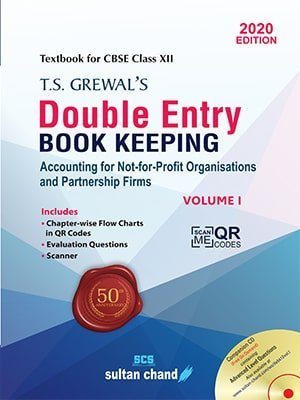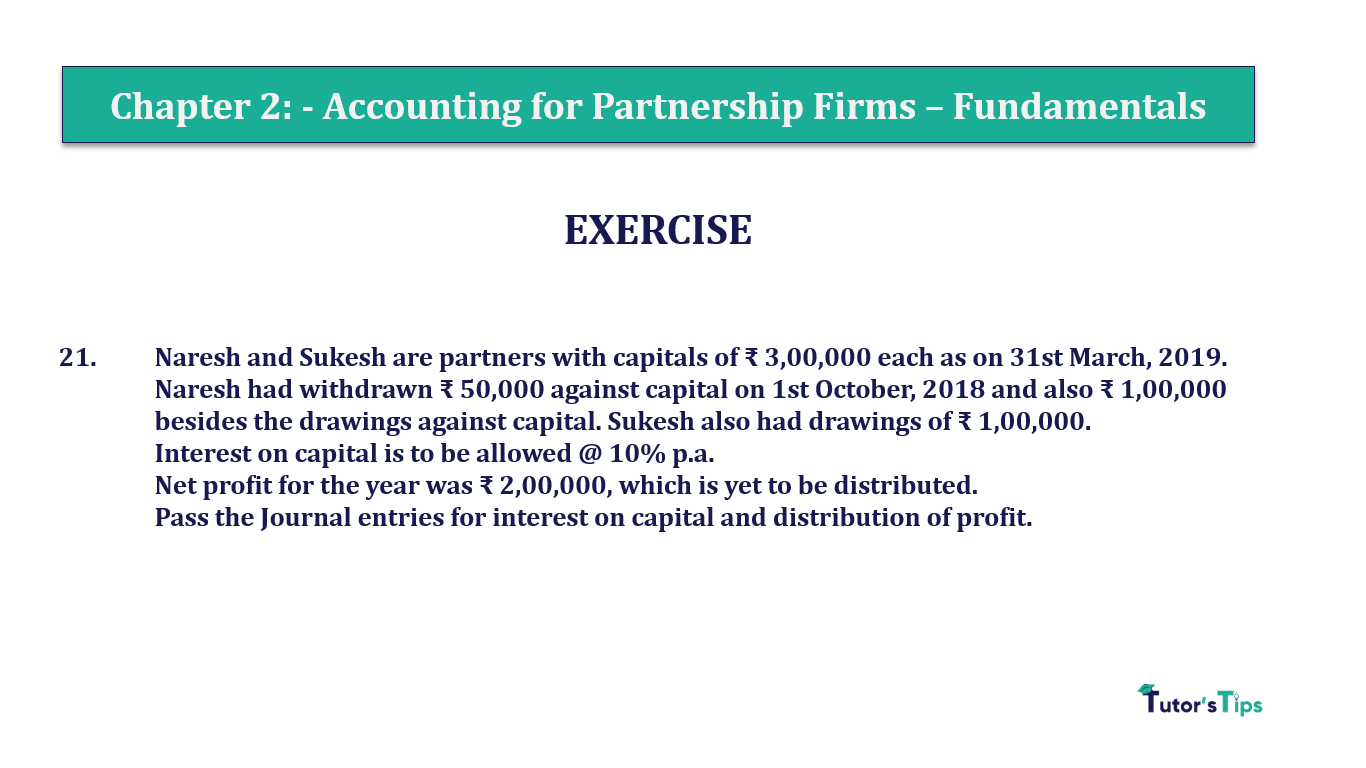Question 21 Chapter 2 of +2-A
21. Naresh and Sukesh are partners with capitals of ₹ 3,00,000 each as on 31st March, 2019. Naresh had withdrawn ₹ 50,000 against capital on 1st October, 2018 and also ₹ 1,00,000 besides the drawings against capital. Sukesh also had drawings of ₹ 1,00,000.
Interest on capital is to be allowed @ 10% p.a.
Net profit for the year was ₹ 2,00,000, which is yet to be distributed.
Pass the Journal entries for interest on capital and distribution of profit.
The solution of Question 21 Chapter 2 of +2-A:
| Date | Particulars |
L.F. | Debit | Credit | |
| April 1 | Profit and Loss Appropriation A/c | Dr | 82,500 | ||
| To Naresh’s Capital A/c | 42,500 | ||||
| To Sukesh’s Capital A/c | 40,000 | ||||
| (Being interest on capital credited to partners capital account) | |||||
| Profit and Loss Appropriation A/c | Dr | 1,17,500 | |||
| To Naresh’s Capital A/c | 58,750 | ||||
| To Sukesh’s Capital A/c | 58,750 | ||||
| (Profit share transferred among partners) | |||||
| Profit and Loss Appropriation Account A/c for the year ended 31st March 2019 |
||||||
| Particulars |
Amount | Particulars |
Amount | |||
| To Interest on Capital A/c *1 | By Profit and Loss Adjustment A/c | 2,00,000 | ||||
| Naresh’s Capital A/c | 42,500 | |||||
| Sukesh’s Capital A/c | 40,000 | 82,500 | ||||
| To Profit Transferred to *2 | ||||||
| Naresh’s Capital A/c | 58,750 | |||||
| Sukesh’s Capital A/c | 58,750 | 1,17,500 | ||||
| 2,00,000 | 2,00,000 | |||||
Working Note:
*1: -Calculation of Total Interest on Ashish’s Capital, and Aakash’s Capital
| In the Question there closing capital is given. So, we have to calculate opening capital balance as shown below: – |
||
| Particulars |
Amount | Amount |
| Capital Balance at the end of the year | 3,00,000 | 3,00,000 |
| Add: – drawing during the year against Capital | 50,000 | |
| Add: – Drawing during the year against the profit | 1,00,000 | 1,00,000 |
| Capital Balance at the beginning of the year | 4,50,000 | 4,00,000 |
Note: – In this case, the partners introduced and withdrawal their capital during the year, so that’s why we have to calculate the interest on capital according to period.
Interest on Capital = Capital X Rate of Interest X Period
Naresh’s Capital
from the 01/04/2019 to 30/09/2019= 4,50,000
During the year he withdrawal capital of Rs. 50,000, So his Total capital will be 4,00,000 (4,50,000-50,000)
from the 01/10/2019 to 31/03/2020= 4,00,000
Rate of Interest = 10%
So, we have to calculate the depreciation of two periods of 6 months each as shown follows
= (4,50,000 X 10/100 X 6/12) + (4,00,000 X 10/100 X 6/12)
= 22,500 + 20,000
Total Interest on Naresh’s Capital = 42,500/-
Sukesh’s Capital = 4,00,000
= 4,00,000 X 10/100
Total Interest on Sukesh’s Capital = 40,000/-
*2: -Calculation of share of profit of Naresh’s and Sukesh’s
Profit Sharing Ratio = 1:1 (assumed as per provision of act Because ration is not given)
Net Profit after interest= 1,17,500
= 1,17,500 X 1/2
Profit share of Naresh’s = 58,750/-
= 1,17,500 X 1/2
Profit share of Sukesh’s = 58,750 /-
Thanks, Please Like and share with your friends
Comment if you have any questions.
Also, Check out the solved question of previous Chapters: –
T.S. Grewal’s Double Entry Book Keeping +2 (Vol. I: Accounting for Not-for-Profit Organizations and Partnership Firms)
- Chapter No. 1 – Financial Statement of Not-For-Profit Organisations
- Chapter No. 2 – Accounting for Partnership Firms – Fundamentals
- Chapter No. 3 – Goodwill: Nature and Valuation
- Chapter No. 4 – Change in Profit-Sharing Ratio Among the Existing Partners
- Chapter No. 5 – Admission of a Partner
- Chapter No. 6 – Retirement/Death of a Partner
- Chapter No. 7 – Dissolution of a Partnership Firm
T.S. Grewal’s Double Entry Book Keeping (Vol. II: Accounting for Companies)
- Chapter No. 8 – Company Accounts – Accounting for Share Capital
- Chapter No. 9 – Company Accounts – Issue of Debentures
- Chapter No. 10 – Redemption of Debentures
T.S. Grewal’s Double Entry Book Keeping (Vol. II: Accounting for Companies)
- Chapter No. 1 – Financial Statements of a Company
- Chapter No. 2 – Financial Statement Analysis
- Chapter No. 3 – Tools of Financial Statement Analysis – Comparative Statements and Common- Size Statements
- Chapter No. 4 – Accounting Ratios
- Chapter No. 5 – Cash Flow Statement
Check out T.S. Grewal +2 Book 2020@ Official Website of Sultan Chand Publication
Advertisement-X








Leave a Reply